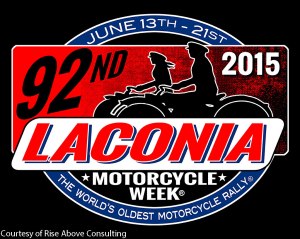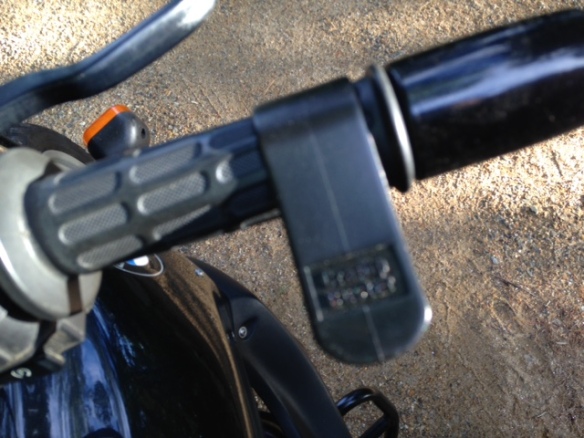Last Thursday evening, I took a leisurely F650 ride around Lake Winnipesaukee and as I passed through the Weirs Beach area, I saw a hundred or so vendor tents already set up for Motorcycle Week. Approaching Meredith, a grand tent covered a very long row of new bikes in front of the Harley Davidson dealership. A huge Kuryakyn trailer loomed over Route 3. It was warm and sunny. Bikes everywhere. Only about 8 miles from home and I was already enjoying myself immensely.

Riding for enjoyment, I became sensitive to gear selections and throttle settings, because the F650 is a big single with inherent vibes in need of taming. Fortunately, there seems to be a very satisfactory gear/throttle optimization for just about every combination of speed, incline, flat, and downhill encountered in the 62 mile circuit of the big lake. I got a lot of pleasure coaxing silky-smooth power out of that simple reliable engine.
The following scenario applies to an unmodified, stock, 1997 BMW F650 single cylinder dual sport bike in good working condition. I does have a new set of Metzler Tourance tires which are a bit streetier than the orginal Michelins. Lake Winnipesaukee is in the foothills of the White Mountains and the frost-weary roads are peppered with twisty sections and small hills, even near the lake. Between the stop lights, 30 mph congested areas, and a straight stretch south of Wolfeboro where traffic can hit 70 mph, you pretty much run the gamut of New England back road conditions.

Vibration versus Load
One of the subtleties of F650 vibration management is the awareness that load causes the engine to run smoother. There is a natural vibration peak at 4000 rpm and it’s more noticeable in the lower gears, where the engine output typically over-matches any load on it.
In fifth gear, the engine is turning 4000 rpm at 60 mph, and the vibration is moderate, tolerable, and lessens going up gradual inclines. Even so, you would tend to avoid travelling at that exact speed. 55 mph is a dream and 65 is very comfortable with the wind just starting to be a factor. Wind aside, you can do 75 comfortably, but I have yet to try it for more than 10 or 15 minutes.
In the lower gears, the 4000 rpm vibe is a good signal to upshift.
You get the feeling that the 650cc engine size is pretty optimum, because you have enough power but not a big vibey excess.
RPM Versus Speed
The F650 has the happy characteristic of tachometer correlation with the speedometer. While a bit of a simplification, you can comfortably loaf along with the engine at 3000 – 4000 rpm, and in that rpm zone, you are doing 10-20 in first, 20-30 in 2nd, 30-40 in 3rd, 40-50 in 4th, and 50-60 in fifth. Another way of putting it is the teens are for first, the 20s for 2nd, the thirties for third, the forties for 4th, and everything else is for 5th.
The low fifties are a bit slow for 5th, power-wise, and you don’t want to lug the engine, and fortunately 4th and 5th overlap a bit and you can comfortably hit 55 in 4th before upshifting.
A noticeable “smoothness problem zone” is 40 mph. In third, you are running a lot of excess power at 4000 rpm and the resulting vibes are enough to make you want to do something about it. 4th is a little weak at that speed, meaning it will still pull, but you feel like you are lugging the engine unnecessarily.
Inclines
Relaxed cruising up inclines is best done at 3700-3900 rpm where the engine is putting out decent torque (peaks at 5000), but no vibration. In 4th or 5th, you will just notice a subdued, 4K vibe peak.
Accelerating
You can always comfortably accelerate through the 4k peak in any gear.
In a lively acceleration scenario, like pulling ahead of traffic when the light turns green, I’ll briefly punch the throttle up through 4K before up-shifting and that leaves you a good bit above 3K to pull the rpms back up towards 4K or more.
A more leisurely acceleration might find me trying to pull from 3K and in that case I’ll let it ease on up more gradually from there.
The tachometer is good to have when you are pulling from low rpms, because if they are too low, you need to downshift.
Roar
Roar is engine loudness, approaching a scream above 5000 rpm. I suppose it is mostly exhaust sound, but intake and mechanical noise are there also. Roar seems to be a combination of high rpms and load. At 5000 rpm 5th gear, the engine is beginning to roar, whereas 1st gear roars earlier. You often need to roar in first to get enough speed to upshift. There seems to be an awkward zone between 1st and 2nd. You can easily start off in 2nd, but it seems like you are asking too much of the clutch when doing that.
In the vicinity of 5000 rpm, roar begins to flood your senses and you can confuse it with vibration. In general when you are focused on engine vibration, you are apt to be confused by roar, tire noise, road surface texture and and wind noise.
Low Speed Issues
The F650 is carbureted (dual carbs for a single cylinder) and it is common for it to surge a bit in the 2-3K rpm range. You can pull in 1st gear from 2.5K, but otherwise you want to stay away from that range.
Going down a hill you might get below 3K and then want to speed up and there you really want to be graceful with the throttle, easing it from off to on.
Like keeping the bike upright, the throttle is initially a twitchy thing, requiring some deep tracks burned in your brain before you can enjoy the easy grace of experience.
Conclusion
You can get a lot of enjoyment and satisfaction from the practiced application of throttle and from mastering the nuances of engine and gearing characteristics. You can get that simple, inexpensive motorcycle to run smoothly, to loaf along forever carrying you and your gear.



